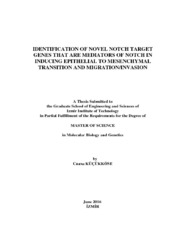Please use this identifier to cite or link to this item:
https://hdl.handle.net/11147/4836| Title: | Identification of Novel Notch Target Genes That Are Mediators of Notch in Inducing Epithelial To Mesenchymal Transition and Migration/Invasion | Other Titles: | Notch Yolağının Epitelyal-mezenkimal Geçişte ve Migrasyon/invazyon Tetiklemede Aracı Olarak Kullanıldığı Yeni Hedef Genlerinin Tanımlanması | Authors: | Küçükköse, Cansu | Advisors: | Yalçın Özuysal, Özden | Keywords: | Breast cancer Molecular biology Notch signaling |
Publisher: | Izmir Institute of Technology Izmir Institute of Technology |
Source: | Küçükköse, C. (2016). Identification of novel Notch target genes that are mediators of Notch in inducing epithelial to mesenchymal transition and migration/invasion. Unpublished master's thesis, İzmir Institute of Technology, İzmir, Turkey | Abstract: | Notch signaling has first been described in murine mammary gland by the proviral integration of mouse mammary tumor virus (MMTV) into the Notch4 locus (Int3 locus) which resulted expression of constitutively active form of Notch4 and transformation of mammary epithelial cells. Notch1 is highly expressed in breast cancer and constitutively active form of Notch1 induces neoplasm. In breast cancer, overexpression of active Notch1 receptor (NICD) promotes epithelial-mesenchymal transition (EMT) via Snail induction which demonstrates the role of Notch signaling in induction of metastasis through EMT. However, the downstream mediators of Notch in EMT, migration and invasion processes are still elusive. In this study, we hypothesized that Notch signaling induces EMT and migration via regulating one or more of the seven candidate genes that are SEMA6D, SEMA3C, CXCR7, CXCL14, CCL20, HMGA2 and CYR61 which were shown to be differentially regulated by Notch signaling in breast cells in microarray data. The candidate genes are involved in EMT and migration in different cell types and tissues. We showed that Notch1 activation in normal breast epithelial cell line MCF10A significantly increased both mRNA and protein expressions of SEMA6D and CYR61 while it significantly reduced SEMA3C and HMGA2 mRNA levels. Notch inhibition led to significant reduction in mRNA expression of CYR61, CCL20 and HMGA2 and protein expression of CYR61 only, while the rest of candidate genes were affected slightly in breast cancer cell line, MDA-MB-231. We chose SEMA6D for further investigation because there is no data indicating the role of SEMA6D in breast cancer in the literature. SEMA6D could be mediator of Notch signaling to induce EMT because it partially rescues negative effect of Notch inhibition on EMT markers. Notch independent effect of SEMA6D suggested that SEMA6D may be involved in inhibiting EMT whereas, it induced migration and cell viability in MDA-MB-231 cell line.Further analysis is required to reveal the role of SEMA6D in EMT and migration. Notch yolağı’nın meme kanserindeki rolü ilk olarak MMTV (Mouse mammary tumor virus) virüsünün Notch4 lokusuna (Int3 lokus) entegre olup yolağın sürekli olarak aktif olmasına ve buna bağlı olarak meme tümörü oluşumuna yol açmasıyla ortaya çıkmıştır. Meme kanseri hasta örneklerinde aktif Notch1 ifadesinin fazla olduğu ve Notch1’in sürekli aktivasyonunun neoplazm oluşumuna yol açtığı gözlenmiştir. Meme kanserinde, Notch1 almaçının aşırı ekspresyonunun epitelyal-mezenkimal geçişi (EMG), Snai1 üzerinden tetiklediği gösterilmiştir. Fakat Notch yolağının EMG, migrasyon ve invazyonu gerçekleştirmek için hangi alt mekanizmaları kullandığı henüz tam olarak anlaşılmamıştır. Bu çalışmada, Notch’a bağlı EMG, migrasyon ve invazyona yol açan yeni Notch hedef genlerinin tanımlanması amaçlanmıştır. Mikrodizi analizlerinden faydalanılarak, Notch ile ilgisi bilinmeyen fakat, metastazla ilgili çalışmalarda yer alan yedi gen aday olarak belirlenmiştir. Normal meme hücrelerinde, Notch aktivasyonuna bağlı olarak aday genlerin ifadelerinin değiştiği gösterilmiştir. Bu genler, SEMA3C, SEMA6D, CXCL14, CXCR7, CCL20, CYR61 ve HMGA dır. MCF10A normal meme epitel hücre hattında, Notch1 aktivasyonu SEMA6D ve CYR61 mRNA ve protein ifadelerinde anlamlı artışa sebep olurken, HMGA2 ve SEMA3C genlerinin ifadesinde anlamlı azalışa sebep olmuştur. MDA-MB-231 meme kanseri hücre hattında, Notch yolağının inhibasyonu CYR61, CCL20 ve HMGA2 mRNA ifadelerinde ve sadece CYR61 protein ifadesinde anlmalı azalışa sebep olurken, diğer aday genlerinin ifadesinde çok az değişme sebep olmuştur. Bu geneler arasından SEMA6D daha ileri ki araştırmalar için seçilmiştir çünkü literatürde SEMA6D’nin meme kanserindeki rolünü gösteren bir çalışma yoktur. SEMA6D’nin Notch inhibasyonunun EMG belirteç molekülleri üzerindeki negatif etkisini kısmen kurtardığı görülmüştür ve Notch yolağının, EMG ve migrasyonu tetiklemek için SEMA6D yi aracı olarak kullanıyor olabileceği gösterilmiştir. SEMA6D’nin Notch sinyalinden bağımsız etkisi araştırılmıştır ve SEMA6D’nin MDA-MB-231 meme kanseri hücrelerinin yaşama kapasitesini anlamlı artırdığı ve migrasyonu tetiklediği gözlemlenmiştir. |
Description: | Thesis (Master)--Izmir Institute of Technology, Molecular Biology and Genetics, Izmir, 2016 Full text release delayed at author's request until 2018.08.22 Includes bibliographical references (leaves: 5-57) Text in English; Abstract: Turkish an English x, 57 leaves |
URI: | http://hdl.handle.net/11147/4836 |
| Appears in Collections: | Master Degree / Yüksek Lisans Tezleri |
Files in This Item:
| File | Description | Size | Format | |
|---|---|---|---|---|
| T001486.pdf | MasterThesis | 3.09 MB | Adobe PDF |  View/Open |
CORE Recommender
Page view(s)
290
checked on Jun 10, 2025
Download(s)
126
checked on Jun 10, 2025
Google ScholarTM
Check
Items in GCRIS Repository are protected by copyright, with all rights reserved, unless otherwise indicated.